Ochazuke is my favorite after meal dish, a savory option for those who aren’t too big on desserts. It’s warm and comforting and is served with various toppings such as salmon, grilled eel, pickled plum, and pickles. The options are endless! Making it at home is very easy and I have just the right recipe to show you how to make in less than 20 minutes.
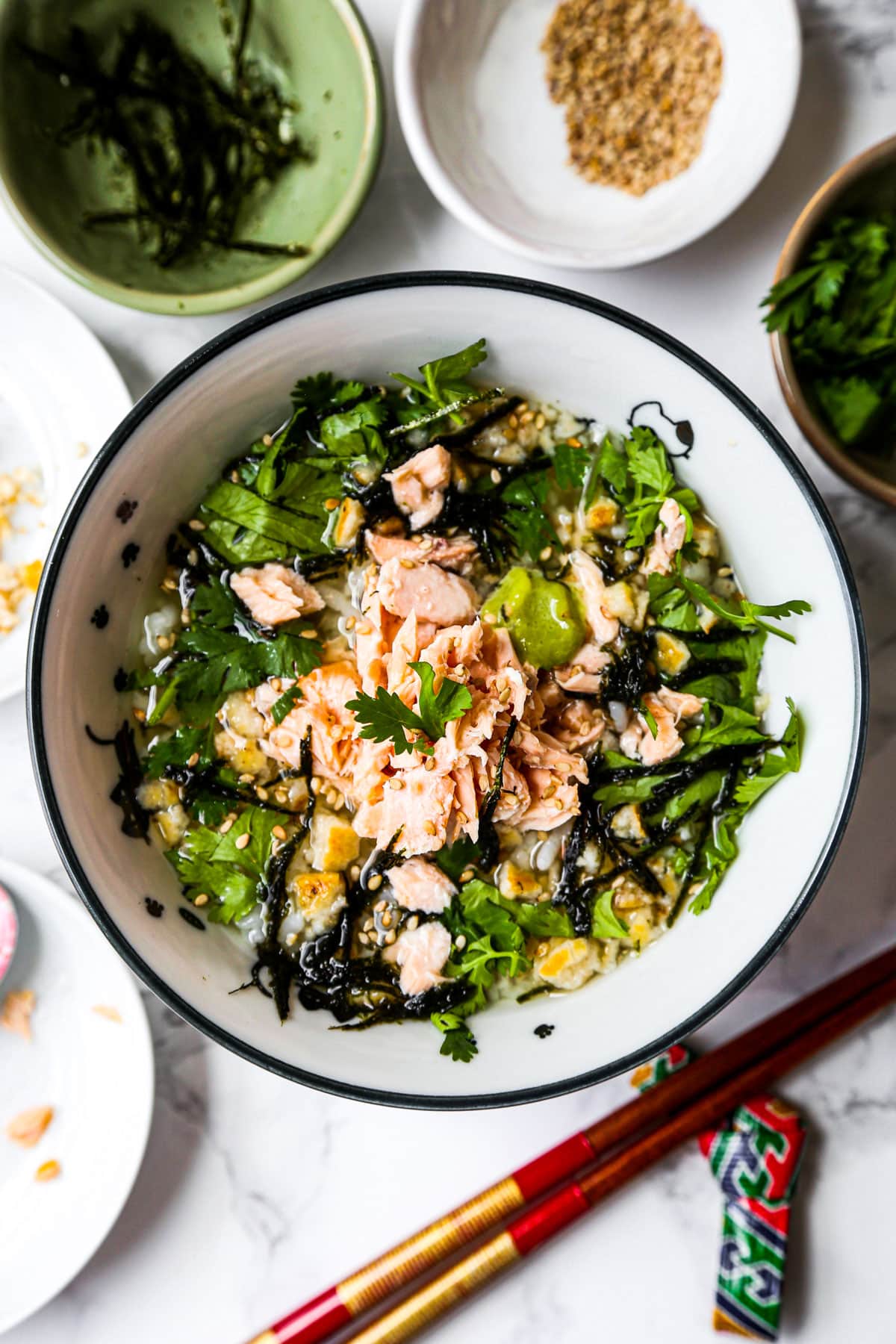
Ochazuke is one of those dishes I have been eating since I was a little girl. Usually served at the end of a meal as a way to use leftover rice and fish, it’s a no frills dish that’s very versatile. I personally like to eat it also as a main or as a late night snack since I could eat ochazuke every day!
In this post I will show you several ways to make this iconic Japanese dish. It’s a fun meal to enjoy with family or something new and unique to serve guests at the end of a meal, who aren’t too familiar with Japanese food. My favorite toppings for ochazuke are salted broiled salmon and pickled plum (served separately), which are both salty. Those are the two main toppings I will be focusing on, although I will give you other options to choose from if you prefer something different.
Table of contents
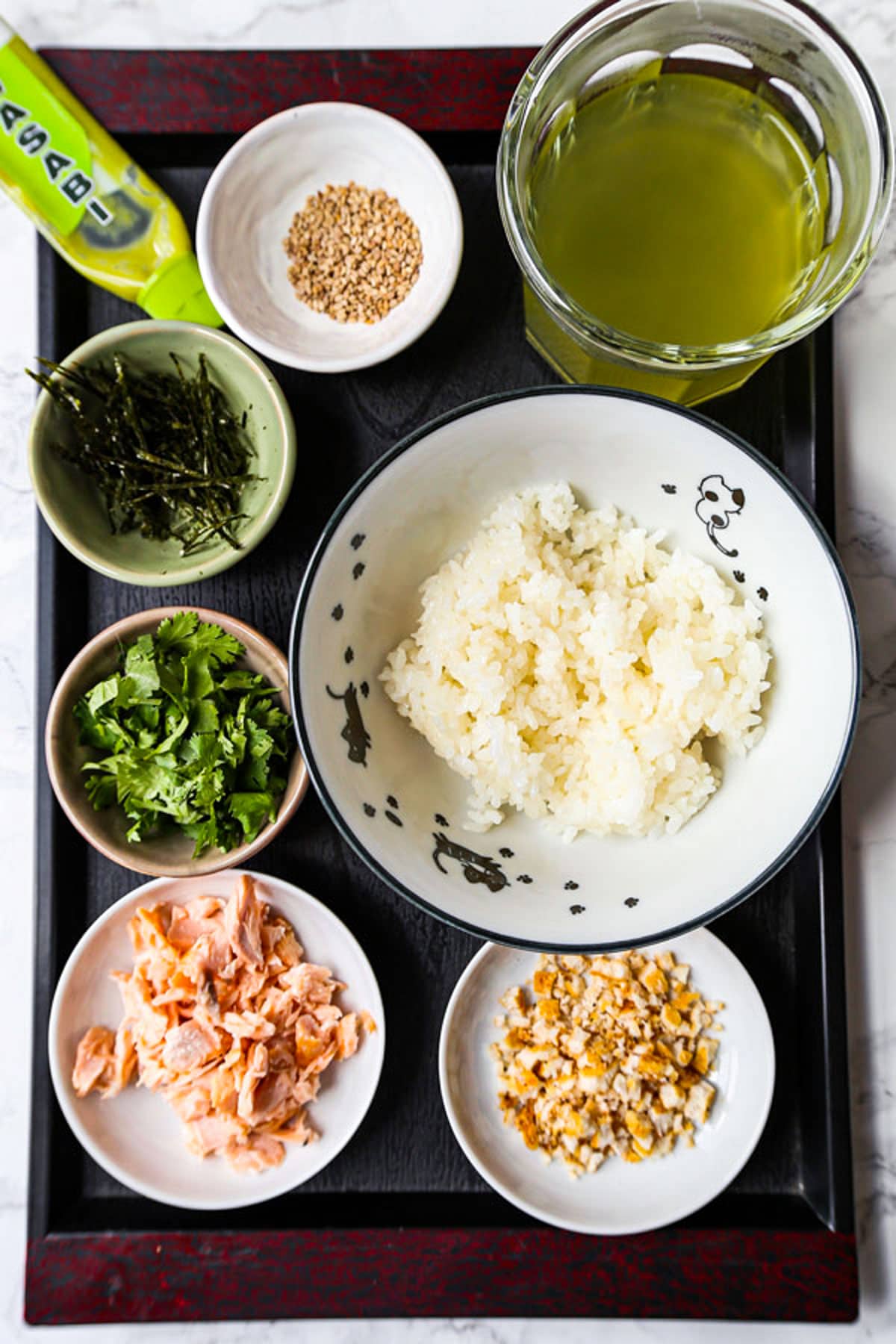
Ingredients
Scroll down to the recipe card for the full recipe.
- Japanese Rice: About 3/4 of a cup of cooked Japanese short grain rice is all you’ll need for a decent sized portion. I use Tamanishiki rice which can be purchased in Japanese supermarket or online.
- Green Tea: Use any type of green tea you have. Don’t get too hung up on the type. Sencha, genmaicha and even hōjicha are good choices. Or, as an alternative to tea, use dashi instead (more on that in a sec).
- Salmon Fillet or Umeboshi: Flaked salmon lends a wonderfully savory flavor to your ochazuke. And umeboshi is a pucker-worthy sour Japanese pickled plum – which I OBVIOUSLY have a true love for 🙂 Even though both are amazing, due to their strong flavors, I’d definitely only use one at a time. Using both in the same bowl might result in an ochazuke that is just a bit too… extra.
- Shredded Nori: Nori, or Japanese seaweed, introduces a slightly toasted and marine essence to the dish.
- Bubu Arare: Formed into tiny pellets, bubu arare are actually toasted and seasoned rice crackers commonly added to ochazuke to impart a crunchy texture. Alternatively, just crushing up a Japanese rice cracker snack (osenbei) should do the trick.
- Sesame Seeds: For a subtle nutty undertone.
- Mitsuba, Shungiku or Cilantro: A little green garden freshness goes a long way to round out the flavor profile of a good ochazuke.
- Wasabi: While this is optional, a bit of wasabi really rounds the dish out with a bit of a spicy bite.
- Soy Sauce: A little splash of regular Japanese soy sauce will up the savory aspect of the dish without going full on salty. I definitely like my chazuke on the umami side of things.
Variations
- Various toppings: When making ochazuke, the options for toppings are endless. Other than broiled salmon and pickled plum you can use furikake, chopped pickles, chopped green onions, seasoned tofu, shredded chicken, grilled eel, a poached egg, and the list goes on.
- Soup flavors: The two most popular liquids used to make ochazuke are dashi broth and green tea. But feel free to use other types of broth such as chicken broth, or kombu dashi instead of a bonito flakes based dashi.
- Using what you already have: This is a great recipe to use leftover salmon that’s already cooked, or other cooked protein. Without the need to broil, this ochazuke recipe will be ready in only 5 minutes!
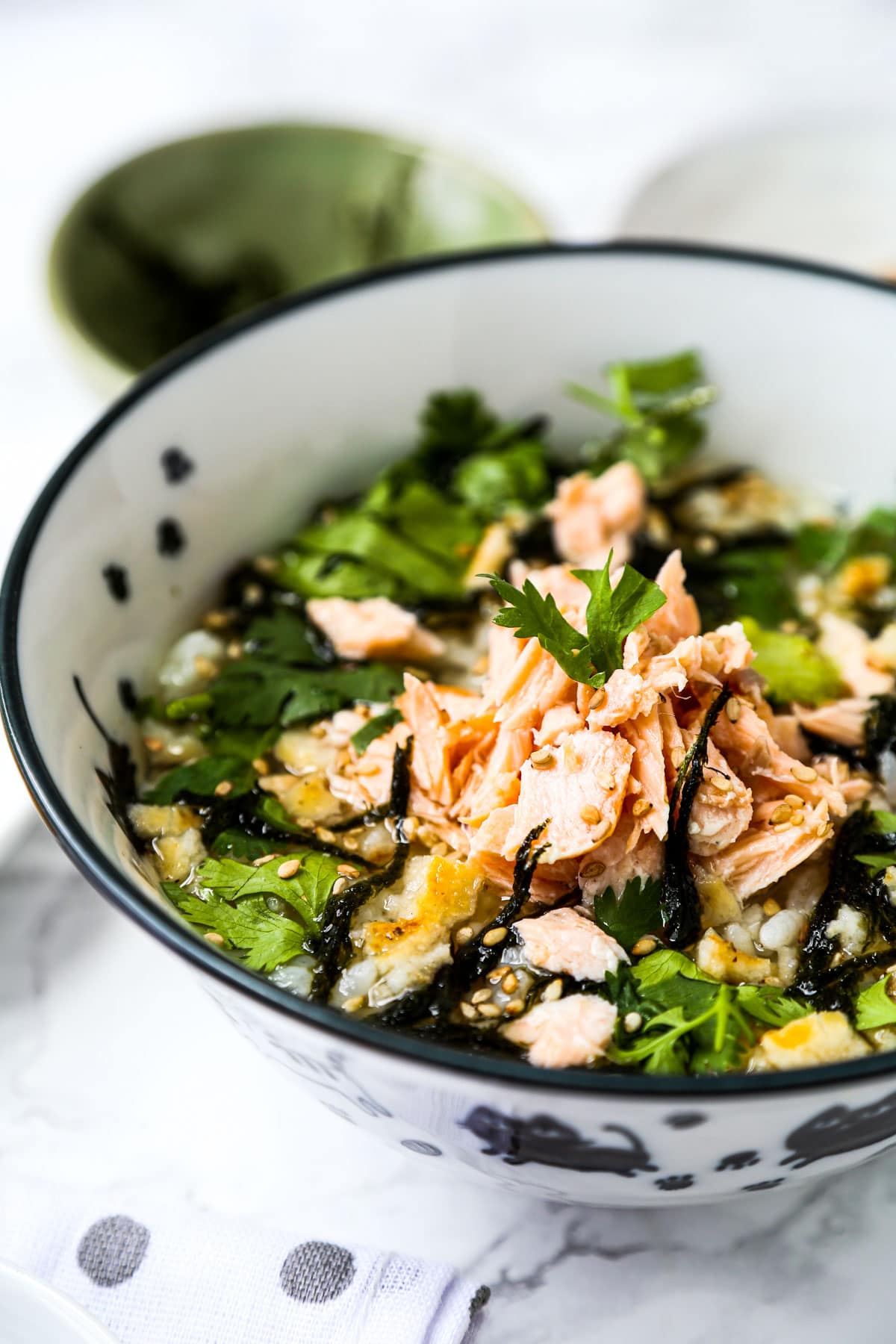
How to Make It
- Sprinkle both sides of a small salmon filet with salt and place on a cooking tray covered with parchment paper.
- Turn the oven to broil and move the oven rack to the highest position. Broil the salmon for 10-12 minutes, until cooked through. Use a fork or chopsticks to break the salmon into small flakes.
- Place about 3/4 cup cooked rice in a bowl and then pour enough green tea to cover 3/4 of the rice.
- Add flaked salmon or umeboshi – along with nori (seaweed), crushed rice cracker, sesame seeds, wasabi, soy sauce and chopped greens (like mitsuba or cilantro) – and serve immediately.
Expert Tips
- Warm or hot rice: Only use warm or hot rice to make ochazuke since the heat from the tea won’t be hot enough to warm up cold rice. Plus, cold rice will cool down the temperature of the tea, rendering the dish tepid, instead of hot and comforting.
- Only pour the tea right before eating: Warm cooked rice absorbs liquid very quickly and can turn ochazuke into a mushy rice that’s soupless. Therefore it’s important to only pour the tea or dashi just before eating the dish.
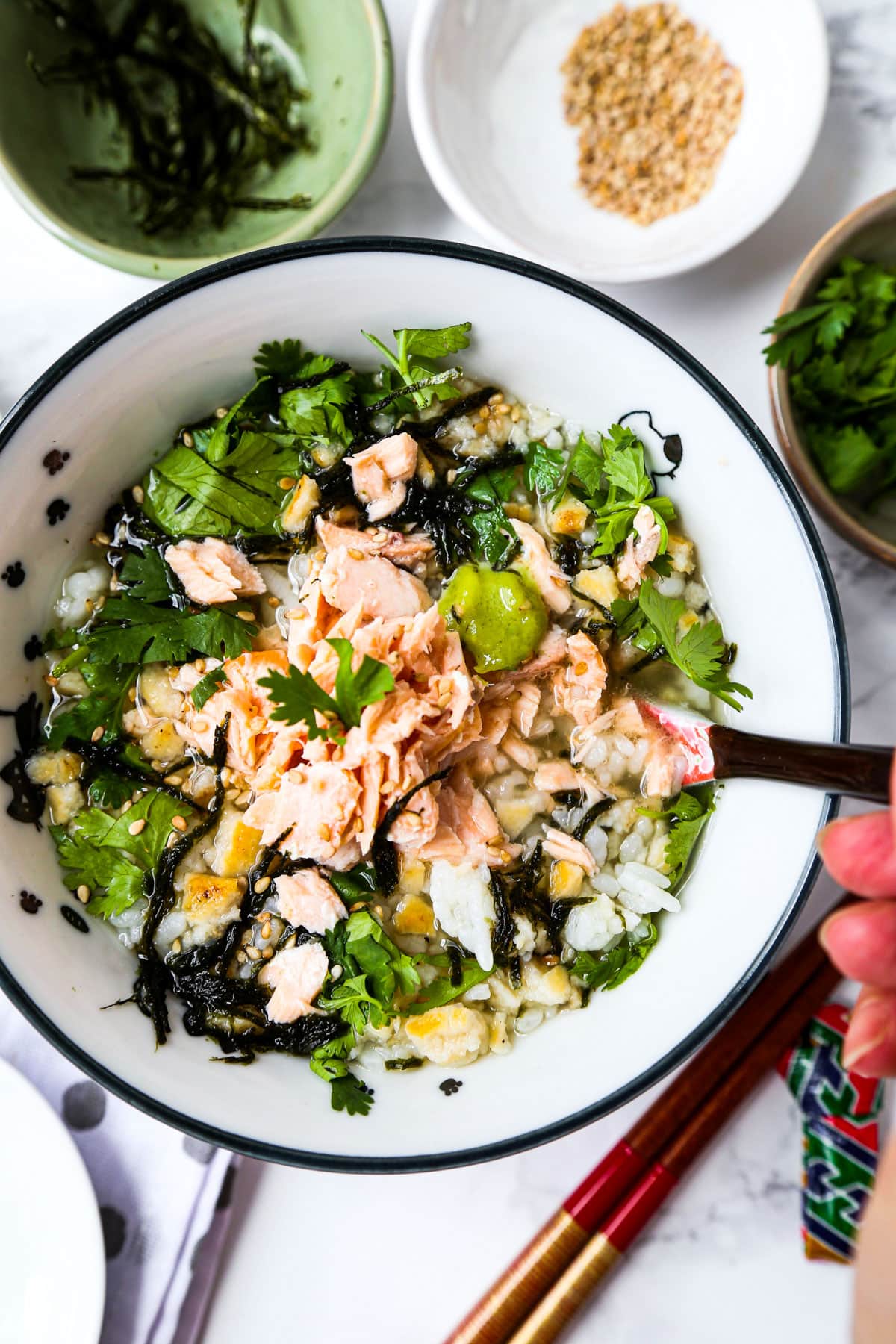
What To Serve With It
Ochazuke is one of those rare dishes that can be the substantial final course of a meal of otherwise small plates at an izakaya, a stand alone main, or an easy late night snack.
The subtle savory, clean flavors won’t go head to head or clash with other elements of your dinner. So why not make a meal out of it? Here are some of my favorite izakaya staple dishes to go along with ochazuke:
Agedashi Tofu (Fried Tofu in Tsuyu Broth), Japanese Restaurant Style Ginger Salad Dressing, Nasu Dengaku (Miso Glazed Japanese Eggplant), Japanese Curry, Spicy Tuna Roll, Baked Chicken Katsu, Beef Yakitori, Tsukune Chicken Yakitori, Tamagoyaki, and Edamame with Soy and Sesame Sauce.
Plus:
Frequently Asked Questions
Yes you absolutely can! The traditional recipe asks that you use short grain Japanese rice but feel free to use other types of rice such as brown rice or jasmine rice.
Yes, ochazuke is gluten-free so long as soy sauce isn’t used. If you do like the taste of soy sauce I recommend using gluten-free soy sauce or tamari.
Yes, they are the same thing. Chazuke is the shortened version of ochazuke.
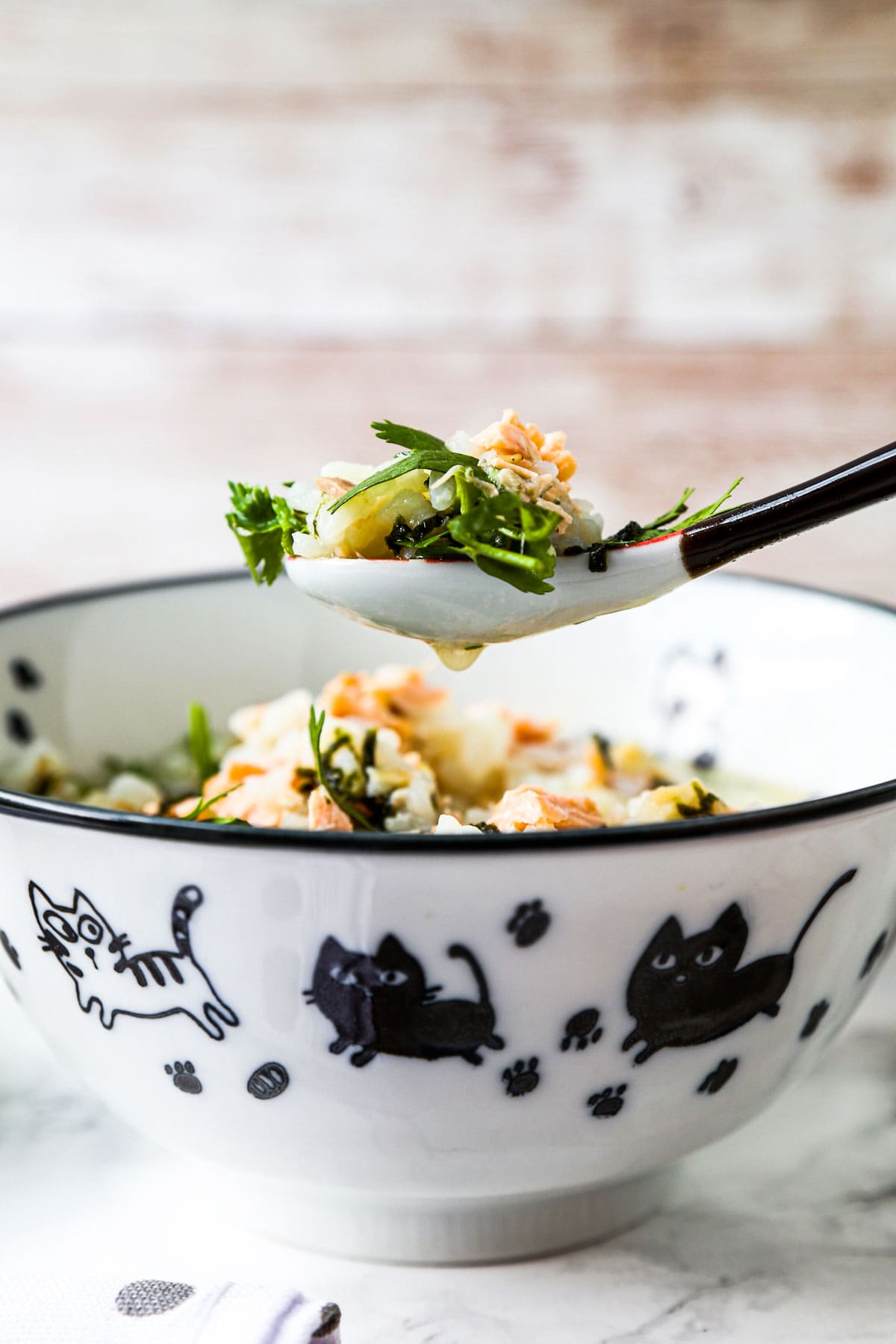
Did you like this recipe? Are there changes you made that you would like to share? Share your tips and recommendations in the comments section below!
Print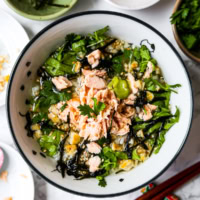
Ochazuke (Japanese Rice Tea Soup)
- Prep Time: 5 minutes
- Cook Time: 12 minutes
- Total Time: 17 minutes
- Yield: 1 person 1x
- Category: Rice
- Method: Broiling
- Cuisine: Japanese
- Diet: Low Calorie
Description
Ochazuke is an iconic Japanese rice soup made with tea and various toppings. It’s very easy to make and tastes delicious!
Ingredients
- 3/4 cup cooked, warm Japanese rice
- 1 cup hot green tea
- 1/4 pound salmon fillet, or 1 Japanese pickled plum (umeboshi)
- 2 teaspoons shredded nori (seaweed)
- 1 teaspoon bubu arare (baked rice cracker balls) or crumbled Japanese rice crackers
- 1/4 teaspoon sesame seeds
- 2 tablespoons shungiku, mitsuba, or cilantro, chopped
- wasabi (optional)
- Soy sauce (optional)
Instructions
- Season the salmon: Sprinkle salt on both sides of the salmon filet and transfer to a cooking tray covered with parchment paper.
- Broil the salmon: Turn the oven to broil and move the oven rack to the highest position. Broil the salmon for 10-12 minutes, until cooked through. Use a fork or chopsticks to break the salmon into small flakes.
- Add tea to the rice: Put the rice in a bowl and pour enough green tea to cover 3/4 of the rice.
- Top and serve: Add all the toppings and serve immediately.
Notes
For dashi based ochazuke, use 1 cup of dashi instead of green tea and stir in a dash of soy sauce and mirin (about 1/2 teaspoon each), and a sprinkle of salt. To learn how to make dashi at home, read this post.
Nutrition
- Serving Size: 1 serving
- Calories: 323
- Sugar: 0.1g
- Sodium: 46.3mg
- Fat: 4.8g
- Saturated Fat: 1g
- Unsaturated Fat: 1.6g
- Trans Fat: 0g
- Carbohydrates: 47.8g
- Fiber: 0.7g
- Protein: 20.9g
- Cholesterol: 41.9mg














